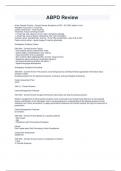ABPD Review
Acute Fluoride Toxicity - Correct Answer Symptoms of OD = GI, CNS, death in 4 hrs
Probable Toxic Dose = 5 mg F/kg
Certain Letal Dose = 16-32 mg F/kg
Treatment: Induce vomiting or bind F
< 8 mg F/kg: milk, observe >6 hrs, refer if symptoms develop
>_8mg F/kg: syrup of ipecac, followed by milk, refer immediate
Unknown dose: asymptomatic, treat as < 8 mg F/kg symptomatic = give milk & refer
Poison control center = gastic lavage IV calcium gluconate
Anticipatory Guidance Topics
(Ref #44) - Correct Answer Topics:
- Oral hygiene (parent, parent/child, child)
- Dietary habits (carbohydrates, fats, sodium)
- Injury prevention (2-3 yrs greatest)
- Non-nutritive habits (digital/pacifier, bruxism, tongue thrust)
- Substance abuse (smoking & smokeless tobacco)
- Intra/perioral piercing (preteen talk about -)
- Speech/language development
Anticipatory Guidance/Counseling
(Ref #44) - Correct Answer The process of providing practical, developmentally-appropriate information about
children's health,
to prepare parents for the significant physical, emotional, and psychological milestones.
Caries Assessment Tool
(CAT)
(Ref # ) - Correct Answer ...
Caries Management Protocols
(Ref #45) - Correct Answer Surgical intervention alone does not stop the disease process.
Modern management of dental caries should be more conservative and include early detection of noncavitated
lesions, identification of an individual's risk for caries progression, understanding of the disease process for that
individual, and "active surveillance" to apply preventative measures and monitor carefully for signs of arrestment or
progression.
Caries Management Protocols
for Children
(Ref #45) - Correct Answer Based on a specific patient's
- Risk Levels
- Age
- Compliance with Preventative Strategies
Others:
Don't forget about Diet Counseling, Active Surveillance
Caries-Risk Assessment
(additional)
(Ref #45) - Correct Answer Involve a combination of factors:
1. Diet
2. Fluoride Exposure
, 3. Susceptible Host
4. Microflora that interplay with Social, Cultural, and Behavioral factors.
Defined: the determination of the likelihood of the incidence of caries during a certain time period. Or the likelihood of
change in size or activity of lesions already present.
Caries-Risk Indicators
(Ref #45) - Correct Answer 1. Cause disease directly (microflora)
2. Predict disease (socioeconomic status)
3. Protective factors (fluoride, sugar substitutes, toothbrushing)
Case Structure - Correct Answer ...
Compelete Clinical Exam
(Ref #44) - Correct Answer - General Health/Growth
- Extra-oral soft tissue
- Intra-oral soft tissue
- Intra-oral hard tissue
- TMJ
- Developing Occlusion
- Oral Hygiene & Periodontal Health
- Caries Risk Assessment
- Pain
- Behavior
Cranial Nerves - Correct Answer CN I - Olfactory (smell)
CN II - Optic (vision)
CN III - Oculomotor (eyelid & eyeball mvmt)
CN IV - Trochlear (innervates superior oblique. Turns eye down & laterally)
CN V - Trigeminal (chewing, face & mouth touch and pain)
CN VI - Abducens (turns eye laterally)
CN VII - Facial (facial expressions, secretions of tears & saliva, taste)
CN VIII - Vestibulocochlear (hearing, equilibrium)
CN IX - Glossopharyngeal (taste, carotid blood pressure)
CN X - Vagus (aortic blood pressure, slowes hr, stimulates digestive organs, taste)
CN XI -Spinal Accessory (trapezius & SCM, swallowing mvmts)
CN XII Hypoglossal (tongue mvmts)
Definitions: - Correct Answer "Leukocyte"
White Blood Cells (WBS). Can be divided into Granulocytes and Agranulocytes. Comprised of Neutrophils,
Eosinophils, Basophils, Lymphocytes, Monocytes, Macrophages, Dendritic Cells.
"Neutrophil"
Most common WBC. Phagocyte, short-lived, in bloodstream. First immune responders.
"Histiocytes"
A type of immune cell that eats foreign bodies. Do NOT travel through blood.
"Langerhans Cells"
A type of histiocyte that normally reside in skin and fight infection and foreign bodies.
"Leukemia"
Abnormal increase in WBC (Leukocytes) in bone marrow. Crowds out formation of healthy blood cells like platelets.
Thus petechia.
Delayed Eruption of Teeth
(Handbook p21) - Correct Answer Look up.
Dental Caries-Risk Assessment




